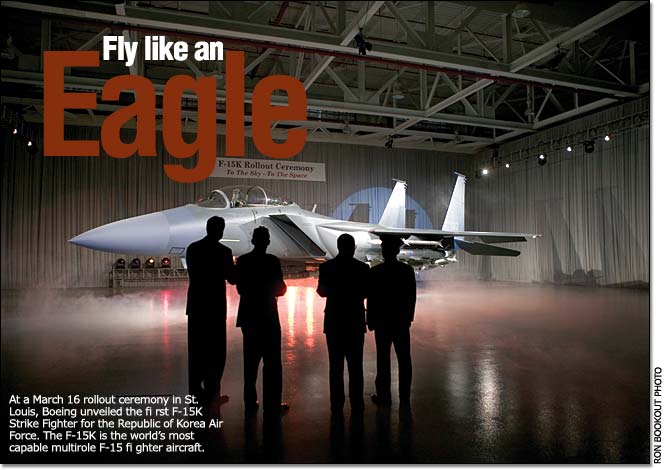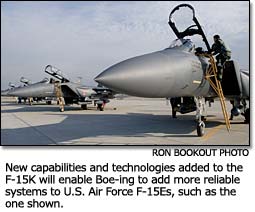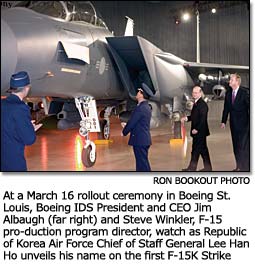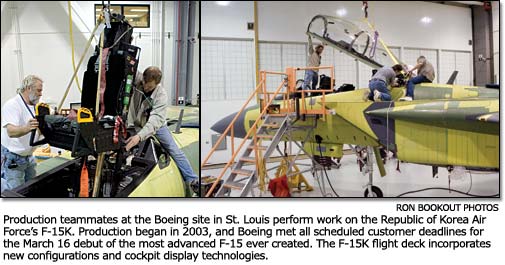|

BY KATHERINE SOPRANOS

F-15K Specifications
Length: 63.8 feet (19.45 meters)
Height: 18.5 feet (5.65 meters)
Wing span: 42.8 feet (13.05 meters)
Propulsion: Two General Electric F110-129A turbofan engines
in 29,000 lb. thrust class with afterburning
Weight: 45,000 lb. (20,411 kg.) class
81,000 lb. (36,700 kg.) maximum gross takeoff
F-15K milestones
April 2003: Boeing began assembly of the central fuselage
October 2004: Final assembly completed
March 2005: Successful completion of the F-15K first flight
in St. Louis
|
|
His nickname is "Ice" for his calmness during pressure
situations. But Korean Air Force pilot Maj. Kim Sung Dae couldn't
mask his emotions minutes before the unveiling of the first F-15K
Strike Eagle fighter aircraft for the Republic of Korea Air Force
(ROKAF). "I'm always very calm and cool, but today, I'm very
anxious, nervous and excited because of the ceremony," Kim
said. "All of us pilots—we are happy."
Kim is one of eight F-15 student pilots
and weapons systems officers who attended the March 16 ceremony
at Boeing in St. Louis. The
ceremony introduced the Republic of Korea's first F-15K, the most
advanced, versatile F-15 Boeing ever created. Kim's elation—as
shared by Boeing, Korea, suppliers and hundreds of dedicated employees
who developed and built the jet—stems from the highly anticipated
debut of this leading-edge aircraft. It integrates the proven F-15
airframe with highly advanced avionics and electronics that provide
exceptional situational awareness and razor-sharp precision targeting—in
any weather, day or night.
"Korea wanted a true, multirole fighter," said Steve
Winkler, director, F-15 production programs. "Everyone on
the team has been highly energized—and proud to make the
best fighter in the world that meets Korea's mission needs."
The Republic of Korea selected the F-15K Strike Eagle for its
Next Generation Fighter Program in 2002. Under a $3.6 billion contract,
Boeing will deliver 40 F-15Ks to the ROKAF by August 2008. Korea
will introduce the first two aircraft in October at the Seoul Air
Show.
 "With the rollout of this airplane, the Republic of Korea
will have the most capable F-15 in the world," said Jim Albaugh,
Boeing Integrated Defense Systems president and CEO. "The
F-15K brings new levels of performance in payload, survivability
and precision strike to their Air Force. This fighter is the result
of the hard work of the many men and women of Boeing who have committed
themselves to satisfying our customer's requirements." "With the rollout of this airplane, the Republic of Korea
will have the most capable F-15 in the world," said Jim Albaugh,
Boeing Integrated Defense Systems president and CEO. "The
F-15K brings new levels of performance in payload, survivability
and precision strike to their Air Force. This fighter is the result
of the hard work of the many men and women of Boeing who have committed
themselves to satisfying our customer's requirements."
The F-15K is the latest version of the
U.S. Air Force F-15E. Where the F-15E is a superior long-range
interdiction fighter for the
USAF, the F-15K enhances air-to-air and air-to-ground modes and
adds new air-to-sea capabilities—making it the most versatile
long-range multirole fighter.
"Integration of the world's best multirole fighter into our
force will certainly be a great momentum in improving our air power," said
Gen. Lee Han Ho, the Republic of Korea Air Force Chief of Staff. "Moreover,
the F-15K will enhance the interoperability between the Republic
of Korea and the U.S. Air Force."
"The F-15K brings new things for [our] relationship with
Korea," said Maj. Gen. Jack Hudson of the U.S. Air Force. "It
brings new capabilities to coalition warfare training, planning
and interoperability."
 Many upgrades Many upgrades
What makes the F-15K the best of the best? The addition of new
capabilities and upgraded systems makes the F-15K even more lethal,
survivable and maintainable than the F-15E, Winkler said. The
F-15K upgrades include
- Enhanced air-to-air capabilities. The Joint Helmet-Mounted
Cueing System enables the pilot to move his or her head, and
the missile's seeker will follow where the head turns. As a result,
the pilot doesn't have to reposition the aircraft to shoot
and
can remain in a defensive position. The F-15K's AIM-9X Sidewinder
missile is an advanced short-range air-to-air missile.
- Enhanced air-to-ground capabilities. The
Standoff Land Attack Missile–Expanded Response improves long-range air-to-ground
capabilities. The addition of smart weapon stations allows the
F-15K to carry up to 15 Joint Direct Attack Munitions—two
times more than the F-15E.
- Air-to-sea capabilities. The Harpoon Block II missile
and associated radar modes provide for air-to-sea combat.
-
Powerful computing
and processing system. The F-15K
features the new Honeywell Advanced Display Core Processor,
which serves
as the central computer, or "brains," of the airplane.
It has 10 times more processing capability than the F-15E's
central computer. The U.S. Air Force, added Winkler, will retrofit
its
F-15Es with the ADCP.
- Advanced, next-generation cockpit. The two-seat F-15K
cockpit incorporates new configurations and cockpit display
technologies. It has a state-of-the-art navigation and weapons
data display.
- High-powered radars and electronic
warfare equipment. The F-15K will use the newest and more reliable combat radar,
the Raytheon AN/APG-63(v)1, which adds new search and target
detection
capabilities and has 10 times more computing power than its
predecessor. The aircraft's electronic-warfare suite also includes
Lockheed
Martin's ALR-56C(v)1 radar-warning receiver, which is more
responsive to threats, and the Northrop Grumman ALQ-135M high-power
jammer.
- Communication upgrades. The
aircraft also now includes a fighter data-link system that allows
information sharing among
every F-15K aircraft on the mission, reducing the need for
radio communications. "No words need to be transmitted over the
radio to engage a target set. It takes the voice [communications]
out of the equation and makes [the flight] less vulnerable to detection
by and interference from the enemy," Winkler said.
"The F-15K is the next big step in the lifeline of the F-15
because of its modernization and superior capabilities," Winkler
said. "It's important to us, too, because it supports the
F-15 program." The F-15K enables Boeing to add more highly
reliable systems to the F-15E.
The USAF currently plans to fly the F-15E beyond 2030, and technology
and system upgrades are planned throughout that period. Korea also
would have access to the USAF-developed upgrades for its F-15Ks.
In addition to producing F-15Es for the USAF, Boeing is exploring
other international opportunities for the F-15 program. Currently,
Israel, Japan and Saudi Arabia fly F-15s.

katherine.sopranos@boeing.com
|

